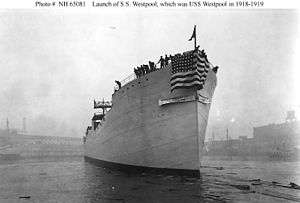USS Westpool (ID-3675)
USS Westpool (ID-3675) – sometimes written as West Pool – was a cargo ship of the United States Navy that served during World War I and its immediate aftermath.`As SS Westpool, she was sunk during World War II after being sold to the United Kingdom for use as a merchant ship.
 SS Westpool just after launching at the J. F. Duthie and Company shipyard in Seattle, Washington, in 1918. | |
| History | |
|---|---|
| Name: | USS Westpool |
| Builder: | J. F. Duthie and Company, Seattle, Washington |
| Launched: | 1918 |
| Completed: | 1918 |
| Acquired: | 2 November 1918 |
| Commissioned: | 2 November 1918 |
| Decommissioned: | 31 March 1919 |
| Stricken: | 31 March 1919 |
| Fate: | Returned to U.S. Shipping Board 31 March 1919 |
| Notes: |
|
| General characteristics | |
| Type: | Cargo ship |
| Tonnage: | 5,650 gross tons[1] |
| Displacement: | 12,170 tons |
| Length: | 410 ft 5.25 in (125.1014 m) |
| Beam: | 54 ft 0 in (16.46 m) |
| Draft: | 24 ft 1 in (7.34 m) (mean) |
| Depth: | 29 ft 9 in (9.07 m) |
| Propulsion: | One 3,000-ihp (2.237-mW) steam engine, one shaft |
| Speed: | 11.5 knots (21.3 km/h; 13.2 mph) |
| Complement: | 103 |
| Armament: | none |
Construction and acquisition
Westpool was laid down as the steel-hulled, single-screw Design 1013 commercial cargo ship SS Westpool by J. F. Duthie and Company in Seattle, Washington, for the United States Shipping Board. Completed in 1918, she was inspected by the U.S. Navy for possible World War I service and given the naval registry identification number 3675. The Shipping Board transferred her to the Navy on 2 November 1918, and the Navy commissioned her at Seattle the same day as USS Westpool (ID-3675) under the command of Lieutenant Commander W. H. Harstedt, USNRF.[2][3]
Navy career
Departing Seattle on 8 November 1918 – three days before the armistice with Germany that brought World War I to an end – Westpool steamed to the Panama Canal Zone, where she loaded a cargo for the Panama Railroad Company. She departed the Canal Zone on 9 December 1918 and proceeded to New York City, where she arrived on 20 December 1918 and discharged her cargo. She then loaded 5,002 tons of United States Army cargo and departed New York on 1 February 1919, bound for Antwerp, Belgium.[4]
Arriving at Antwerp on 18 February 1919, Westpool unloaded part of her cargo before moving to Swansea, Wales, late in February 1919. She discharged the rest of her cargo there between 1 and 5 March 1919, then got underway on 5 March 1919 for New York City, where she made port on 23 March 1919.[5]
Decommissioning and disposal
Westpool was decommissioned at New York on 31 March 1919. She was simultaneously struck from the Navy list and transferred back to the U.S. Shipping Board that day.[6][7]
Later career
Once again SS Westpool, the ship remained under Shipping Board control and was in and out of service at various times until the late 1930s.
Early in World War II, the British government purchased Westpool to help to alleviate the shipping shortage the United Kingdom faced due to losses to German submarines. After a brief career in British service, Westpool was on a voyage from Halifax, Nova Scotia, Canada, to Liverpool, England, carrying 7,144 tons of scrap iron as a part of Convoy SC 26 when she was sunk on 3 April 1941 by the German submarine U-73 with the loss of 35 members of her crew.[8][9]
Notes
- Online Library of Selected Images: Civilian Ships: S.S. Westpool (American Freighter, 1918). Served as USS Westpool (ID # 3675) in 1918-1919
- Online Library of Selected Images: Civilian Ships: S.S. Westpool (American Freighter, 1918). Served as USS Westpool (ID # 3675) in 1918-1919
- NavSource Online: Section Patrol Craft Photo Archive Westpool (ID 3675)
- Online Library of Selected Images: Civilian Ships: S.S. Westpool (American Freighter, 1918). Served as USS Westpool (ID # 3675) in 1918-1919
- Online Library of Selected Images: Civilian Ships: S.S. Westpool (American Freighter, 1918). Served as USS Westpool (ID # 3675) in 1918-1919
- Online Library of Selected Images: Civilian Ships: S.S. Westpool (American Freighter, 1918). Served as USS Westpool (ID # 3675) in 1918-1919
- NavSource Online: Section Patrol Craft Photo Archive Westpool (ID 3675)
- Online Library of Selected Images: Civilian Ships: S.S. Westpool (American Freighter, 1918). Served as USS Westpool (ID # 3675) in 1918-1919
- NavSource Online: Section Patrol Craft Photo Archive Westpool (ID 3675)
References
- This article incorporates text from the public domain Dictionary of American Naval Fighting Ships. The entry can be found here.
- Online Library of Selected Images: Civilian Ships: S.S. Westpool (American Freighter, 1918). Served as USS Westpool (ID # 3675) in 1918-1919
- NavSource Online: Section Patrol Craft Photo Archive Westpool (ID 3675)